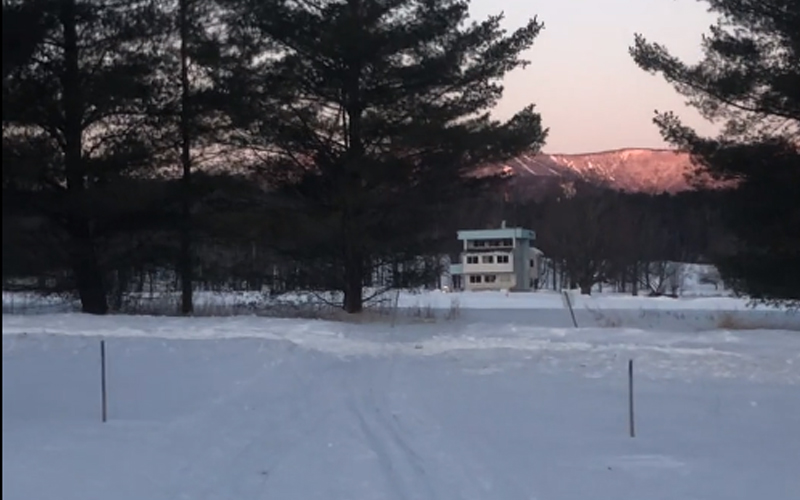Back in the previous century, the influences of skiing's European roots were still alive and well in America. That was evident in the American skiing vernacular, where terms like sitzmark, wedel, and shussboomer were common parlance. Another Euro term that has been all but lost in the mists of passing time: skimeister. A skimeister was someone who was expert in every aspect of the sport, hence the literal translation, "master of skiing."
Skimeister competitions were cool -- skiing's equivalent to triathlons. Combine cross-country racing, downhill racing, and jumping, and whoever could produce the top score in some sort of logarithmic factoring of each competitive component would be declared a meister among skimeisters. Because the typical skier didn't have a pair of 240 cm jumping skis in his/her quiver (and as full-fledged ski jumps, commonplace in the early 20th century, began disappearing), the jumping portion would often involve standard alpine equipment on whatever kind of improvised jump could be found, in what was called -- back to the Euro lexicon -- geländesprung.
Part of the energy driving skimeister events, of course, was an attempt to answer a question that persists into modern times: Who are the better athletes, downhillers or cross-country skiers? That was the seed that sprouted the Stowe Derby in 1945, when Stowe's alpine ski school director Sepp Ruschp and renowned Nordic skier Erling Strom challenged one another to a downhill/cross-country contest.
Unfortunately, the Stowe Derby, as a combined test of downhill and cross-country skills, is a rarity these days. Over the years, the gap, culturally and competitively, between downhill and cross-country skiing has widened, and interest in skimeister competitions has all but evaporated. In some parts of the country -- Colorado, for example -- an effort has been made to keep the concept alive at the high school level, though not very convincingly. A Colorado high school event is held sporadically, is not sanctioned by any official body, and bastardizes the true downhill/XC/jumping skimeister concept by turning it into a four-event, non-jumping competition, with races in giant slalom, slalom, classic cross-country, and skating. When the event was held recently at Steamboat Springs, the venue was Howelson Hill, where the principal feature is a ski jump, but a geländesprung wasn't included. With a jump right there. Go figure.
Locally, the Amateur Ski Club of New York, which encamps every winter in its lodge at the base of Mad River Glen, has hosted a downhill/cross-country competition for its members in the recent past and may continue it in the near future. But like the Stowe Derby and the Colorado high school event, there's no jumping -- no geländesprunging. Again, it's a good test of varied skiing skills, but not quite the same as the triathlon-y way things were back in the sitzmark, wedeling, and schussbooming days.
Nordic combined competitions, involving cross-country skiing and jumping, are still widely contested, including at the Olympics. Nordic combined, however, also falls an event short of a true, skimeister test, and how cool it would be to see three-event skimeister competitions make a comeback. In the meantime, in the skimeister spirit, test yourself by doing it all. Don't shortchange yourself and be good at just one thing.
While both Nordic and alpine skiing might involve sliding on snow, they represent very different tests of athletic skill and fitness. There might be obvious commonalities -- e.g., balance, weight transfer, gliding -- but there are obvious differences, too. A look at the different body types at the elite levels of the sport tells the story: downhill racers are usually blessed with heavily muscled legs to control the powerful forces of making a high-speed turn; cross-country skiers are more likely to be lean, mean aerobic machines, possessing a sinewy upper-body strength for the powerful poling action unnecessary in downhill racing.
The two skiing types are thus complementary -- cross-country skiing relying mostly on aerobic strength and downhill skiing more on muscular strength. Throw in the sheer guts it takes to hurl yourself off a big kicker and stick the landing, and anyone who can do it all well is obviously going to be an admirably well-rounded skier.
If you're a downhiller, dabble in a whole new skill set by trying cross-country. For whatever reasons, downhillers entering the cross-country arena seem to pick up skating faster than classic skiing, perhaps because the use of edges and the pronounced lateral movements of skating have closer similarities to alpine technique. But don't stop with skating; challenge yourself by trying the classic technique as well. And cross-country snobs -- stop disparaging downhillers as overly muscled gravity slaves. Not only can the speed that gravity helps generate be exhilarating, the strength and skill it takes to execute a well-carved (or even not-so-well-carved) turn can be an immensely gratifying and genuine test of balance, power, and finesse. For good measure, go ahead and try zipper-lining a mogul field, tossing in a few hucks along the way.
Skimeistering might be a dormant concept these days, but don't let that put a sitzmark on your enthusiasm for doing it all. Become a true master of skiing.












